INSTITUT SUPERIEUR D'ANTHROPOLOGIE
INSTITUTE OF ANTHROPOLOGY
ONLINE COURSES / COURS A DISTANCE
WINTER TERM : JANUARY 2015
REGISTER NOW
DANEMARK – 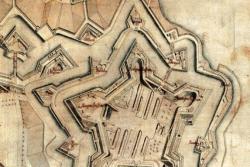 Copenhague - While restoration work is being undertaken at the star fortress Kastellet in the centre of Copenhagen, archaeologists from the Museum of Copenhagen, have had the rare opportunity to thoroughly examine areas of the historic military site. During the search a trove of coins, dated between 1649 and 1787, was found. The trove comprises nine copper coins and 23 silver pieces. In total, 620 metal objects were found in the area, including musket balls and other pieces of used or discarded ammunition. While archaeological finds of old coins, some even from the Viking age, are not as uncommon in some areas of the country, the Museum of Copenhagen emphasises that coin troves are rarely found in the Copenhagen area. Most of the coins were minted in Copenhagen, while some come from Kongsberg in Norway and Altona in Germany, which were both under the Danish crown during the period in question.
Copenhague - While restoration work is being undertaken at the star fortress Kastellet in the centre of Copenhagen, archaeologists from the Museum of Copenhagen, have had the rare opportunity to thoroughly examine areas of the historic military site. During the search a trove of coins, dated between 1649 and 1787, was found. The trove comprises nine copper coins and 23 silver pieces. In total, 620 metal objects were found in the area, including musket balls and other pieces of used or discarded ammunition. While archaeological finds of old coins, some even from the Viking age, are not as uncommon in some areas of the country, the Museum of Copenhagen emphasises that coin troves are rarely found in the Copenhagen area. Most of the coins were minted in Copenhagen, while some come from Kongsberg in Norway and Altona in Germany, which were both under the Danish crown during the period in question.
http://cphpost.dk/news/coins-at-kastellet-archaeologist-strikes-silver.12084.html?
SRI LANKA –  Medagama- Archaeologists excavating the ancient Thimbiriya Raja Maha Vihara at Medagama in Uva Wellassa have discovered 160 old Dutch coins, rings made of copper, glass beads and some clay urns, according to Director General Archaeology Dr. Senarath Dissanayake. The finds belonging to different periods of the country’s past indicated that the temple in the remote Wellassa area had links with maritime and other provinces of the country in ancient times, Dr Dissanayake said. The excavations have yielded evidence which established the fact that the temple had been built during the first half of the Anuradhapura Period, Dr Dissanayake said. "This fact is confirmed by the finding of a Chatra Gala, a circular stone slab used as an umbrella shade for the stupa, near the stupa of the temple. Excavators have also unearthed ruins of several constructions made during the Anuradhapura Period." During the first half of this year archaeologists of the Department had begun excavations at the Thimbiriya Raja Maha Vihara. Their objective was to remove embellishments and additions made during the later days and uncover the original stupa belonging to the Anuradhapura Period, Dr Dissanayake said. "The ancient temple has a Dharma Shalawa (Preaching Hall), Pratima Gruha (Image House) and several other yet to be identified buildings. It seems that the site was a thriving monastery during the ancient times giving shelter to hundreds of bhikkhus. The image house was renovated during the Kandyan Period as evident from some architectural features. There are many sculptures, carvings and paintings belonging to the Kandyan Period in the image house." Dr. Dissanayake said that some scholars had opined that there was a reference to the Thimbiriya Temple in the Saddharamalankaraya, a Sinhala translation of Pali text called Rasavahini compiled in the 14th Century. According to the scholars, the textual reference, ‘Girithimbila Tissa Pabbataramaya’ found in the Saddharamalankaraya is about the Thimbiriya Raja Maha Vihara. There is also a folktale that the temple was built by the King Lajjitissa, the son of King Saddhatissa.
Medagama- Archaeologists excavating the ancient Thimbiriya Raja Maha Vihara at Medagama in Uva Wellassa have discovered 160 old Dutch coins, rings made of copper, glass beads and some clay urns, according to Director General Archaeology Dr. Senarath Dissanayake. The finds belonging to different periods of the country’s past indicated that the temple in the remote Wellassa area had links with maritime and other provinces of the country in ancient times, Dr Dissanayake said. The excavations have yielded evidence which established the fact that the temple had been built during the first half of the Anuradhapura Period, Dr Dissanayake said. "This fact is confirmed by the finding of a Chatra Gala, a circular stone slab used as an umbrella shade for the stupa, near the stupa of the temple. Excavators have also unearthed ruins of several constructions made during the Anuradhapura Period." During the first half of this year archaeologists of the Department had begun excavations at the Thimbiriya Raja Maha Vihara. Their objective was to remove embellishments and additions made during the later days and uncover the original stupa belonging to the Anuradhapura Period, Dr Dissanayake said. "The ancient temple has a Dharma Shalawa (Preaching Hall), Pratima Gruha (Image House) and several other yet to be identified buildings. It seems that the site was a thriving monastery during the ancient times giving shelter to hundreds of bhikkhus. The image house was renovated during the Kandyan Period as evident from some architectural features. There are many sculptures, carvings and paintings belonging to the Kandyan Period in the image house." Dr. Dissanayake said that some scholars had opined that there was a reference to the Thimbiriya Temple in the Saddharamalankaraya, a Sinhala translation of Pali text called Rasavahini compiled in the 14th Century. According to the scholars, the textual reference, ‘Girithimbila Tissa Pabbataramaya’ found in the Saddharamalankaraya is about the Thimbiriya Raja Maha Vihara. There is also a folktale that the temple was built by the King Lajjitissa, the son of King Saddhatissa.
http://www.island.lk/index.php?page_cat=article-details&page=article-details&code_title=116221
ROYAUME UNI - Missenden - £4,000 is needed to help take Buckinghamshire back in time to the 12th Century. That's because hundreds of items found on the Missenden Abbey site are hidden away, and archaeologists want to put them all on show online for us to discover. The 12th Century abbey site, which is owned by Bucks New University and based in London Road, Great Missenden, was founded in 1113 and was one of the early monasteries in southern England. It was excavated during the 1980s and among the archaeologists' findings were several complete human skeletons, animal bones, coins, glass and pottery. Some of the items, such as stained glass, are on display at the Abbey but the majority of the finds and relevant documents were stored at the Museum Resource Centre in Aylesbury. However museum staff, archaeologists and volunteers have now established the Community Archaeology Project with the primary task being to complete the identification of finds, and to digitise and document all the original excavation plans and records. They are planning to publish the results of this work so that more people can discover the history of the Abbey and how people lived there in medieval times.
http://www.mix96.co.uk/news/local/1482669/crowdfunder-could-reveal-bucks-medieval-secrets/
ROYAUME UNI – Pocklington - Ancientskeletons and jewellery from the Iron Age have been unearthed on a building site. The 2,000-year-old human remains from around 800 BC were discovered in a cemetery close to where developer David Wilson Homes is constructing 77 houses in Pocklington. Archaeologists found at least 10 square burial mounds surrounded by small enclosures in the site off Burnby Lane during an initial scan of the ground and excavation work is now being carried out by Malton-based MAP Archaeological Practice Ltd. The finds, which could shortly be deemed of national importance, have sparked a frenzy of excitement in the town. Andrew Sefton, of Pocklington and District Local History Group, added: "They are very significant findings and Pocklington is known as a centre of Iron Age settlements. "There's all sorts of Iron Age findings in the area and Pocklington is said to be one of the main settlements of the Parisi tribe.
http://www.yorkpress.co.uk/news/11679051.Bones_found_at_Pocklington_building_site/
TURQUIE – 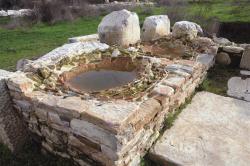
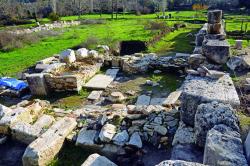 Stratonikeia - The remains of a 300-year-old Ottoman paint shop, which has been discovered at the site of the ancient city of Stratonikeia in the western province of Muğla’s Yatağan district, will soon be opened to tourists. Professor Bilal Söğüt, who heads the excavations in the area, said the site of the shop was unique. “There is no other example of a paint shop in this region. We knew from gravures that there were many agha mansions in the city in the same era and weaving and trade were very important. The paint shop confirmed our data,” Söğüt said. He said they believed further similar findings would be uncovered, as the city’s architecture gave clues about this. Although the area of the paint shop is small, the entrance, furnaces and the places where painting materials were kept are clear to experts. “The area of the paint shop is located on one of the main roads of the ancient city. We don’t have any other example of it from the Ottoman era. This is why we did the conservation and took it under protection. When the work is done, visitors will be able to perceive the architecture of the era. We think this place will be very popular among visitors,” Söğüt said. He also noted that the Ottoman era village square, along with Roman era temples, baths and a parliamentary building, had drawn considerable attention in the ancient city of Stratonikeia.
Stratonikeia - The remains of a 300-year-old Ottoman paint shop, which has been discovered at the site of the ancient city of Stratonikeia in the western province of Muğla’s Yatağan district, will soon be opened to tourists. Professor Bilal Söğüt, who heads the excavations in the area, said the site of the shop was unique. “There is no other example of a paint shop in this region. We knew from gravures that there were many agha mansions in the city in the same era and weaving and trade were very important. The paint shop confirmed our data,” Söğüt said. He said they believed further similar findings would be uncovered, as the city’s architecture gave clues about this. Although the area of the paint shop is small, the entrance, furnaces and the places where painting materials were kept are clear to experts. “The area of the paint shop is located on one of the main roads of the ancient city. We don’t have any other example of it from the Ottoman era. This is why we did the conservation and took it under protection. When the work is done, visitors will be able to perceive the architecture of the era. We think this place will be very popular among visitors,” Söğüt said. He also noted that the Ottoman era village square, along with Roman era temples, baths and a parliamentary building, had drawn considerable attention in the ancient city of Stratonikeia.
http://www.hurriyetdailynews.com/ottoman-paint-shop-to-open-to-tourists.aspx?pageID=238&nid=75794&NewsCatID=375
GRECE – 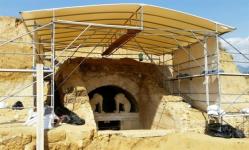 Amphipolis - A geophysical survey was carried out on Kasta Hill, where the mysterious tomb of Amphipolis was discovered, with the results indicating the location of additional man-made structures of archeological importance. By using the scanned images, the archeological team will be able to construct a rudimentary map of the archeological remains hidden within the hill, allowing them to prioritize and arrange future excavations in the area. So far it appears that the geophysical survey that was carried out seems to confirm speculation that the hill is in fact a complex of various constructions. A similar survey of the tomb itself will also be carried out in order to focus the archeological efforts and discover further secrets. Meanwhile a team of Greek scientists has been chosen to carry out the investigation of the bones that were found in the fourth chamber of the tomb. The scientists will determine the age and gender of the deceased, which has so far puzzled archeologists and may help towards determining his or her identity.
Amphipolis - A geophysical survey was carried out on Kasta Hill, where the mysterious tomb of Amphipolis was discovered, with the results indicating the location of additional man-made structures of archeological importance. By using the scanned images, the archeological team will be able to construct a rudimentary map of the archeological remains hidden within the hill, allowing them to prioritize and arrange future excavations in the area. So far it appears that the geophysical survey that was carried out seems to confirm speculation that the hill is in fact a complex of various constructions. A similar survey of the tomb itself will also be carried out in order to focus the archeological efforts and discover further secrets. Meanwhile a team of Greek scientists has been chosen to carry out the investigation of the bones that were found in the fourth chamber of the tomb. The scientists will determine the age and gender of the deceased, which has so far puzzled archeologists and may help towards determining his or her identity.
http://www.tovima.gr/en/article/?aid=660895
GRECE – 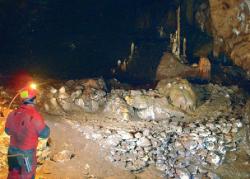 Thassos - Archaeologists and speliologists exploring the Atspas cave, an almost inaccessible cave near the village of Skala Maries on the Greek island of Thassos, identified human cranial bones, as well as animal bones and a large number of sea shells. According to archaeologist Anastasios Syros, a small clay 'table', decorated with incised and impressed patterns, was found in the cave. The 'table', which showed traces of fire, appears to have served as makeshift altar. Nearby, an object carved from animal bone, perhaps a flute, was also discovered. Both items are tentatively dated to the end of the 5th millennium BC. Numerous pottery sherds and building remains dating from the Neolithic to the Early Bronze Age were likewise found. "The pottery as a whole is handmade", says Mr. Syros. "Grooved and impressed wares are common, while painted wares are represented by only two examples, decorated with black and graphite." The surface pottery suggests that the Atspas cave was occupied over a wide chronological range, from the late 5th to early 3rd millennium BC. "Carinated bowls of all sizes are common. Most widespread is the type with deep conical body and vertical or recessed lip, decorated on the shoulder with diagonal grooves or ridges, but there are also open or wide mouthed pithoi, as well as globular jars and amphoroid vessels", said Mr. Syros. Other finds include millstones and pestles, two flint cutting tools and three clay spindle whorls. The researchers also identified iron oxides and traces of mineralization on the walls of the cave which suggests that metal ores may have been mined there. Mr. Syros added that extensive remains of stone structures, some of which are 'monumental' in scale, found within the cave suggest that it was occupied by a populous and highly active community.
Thassos - Archaeologists and speliologists exploring the Atspas cave, an almost inaccessible cave near the village of Skala Maries on the Greek island of Thassos, identified human cranial bones, as well as animal bones and a large number of sea shells. According to archaeologist Anastasios Syros, a small clay 'table', decorated with incised and impressed patterns, was found in the cave. The 'table', which showed traces of fire, appears to have served as makeshift altar. Nearby, an object carved from animal bone, perhaps a flute, was also discovered. Both items are tentatively dated to the end of the 5th millennium BC. Numerous pottery sherds and building remains dating from the Neolithic to the Early Bronze Age were likewise found. "The pottery as a whole is handmade", says Mr. Syros. "Grooved and impressed wares are common, while painted wares are represented by only two examples, decorated with black and graphite." The surface pottery suggests that the Atspas cave was occupied over a wide chronological range, from the late 5th to early 3rd millennium BC. "Carinated bowls of all sizes are common. Most widespread is the type with deep conical body and vertical or recessed lip, decorated on the shoulder with diagonal grooves or ridges, but there are also open or wide mouthed pithoi, as well as globular jars and amphoroid vessels", said Mr. Syros. Other finds include millstones and pestles, two flint cutting tools and three clay spindle whorls. The researchers also identified iron oxides and traces of mineralization on the walls of the cave which suggests that metal ores may have been mined there. Mr. Syros added that extensive remains of stone structures, some of which are 'monumental' in scale, found within the cave suggest that it was occupied by a populous and highly active community.
http://archaeologynewsnetwork.blogspot.fr/2014/12/neolithic-remains-found-in-hidden-greek.html#.VJRkdV4AEA
EGYPTE – 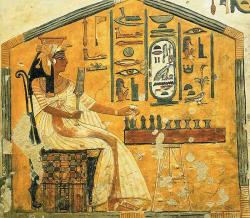 Vallée des Reines - Egypt plans to reopen the royal tomb of Nefertari, a wife of Ramesses II (who reigned from 1279BC to 1213BC), on a regular basis after it was closed for eight years because of concerns over the condition of the site’s wall paintings. The burial site in the Valley of the Queens was opened for ten days in mid-October to celebrate the 110th anniversary of its discovery by the Italian archaeologist Ernesto Schiaparelli. Speaking at an event in London last month, Egypt’s minister of tourism, Hisham Zazou, proposed that the site remains open. “I want to make sure [this period] is expanded, so it is open every month,” Zazou said, adding that the tomb would be open one week a month to a limited number of tourists. Access was restricted to 150 visitors before it was closed in 2006. Nefertari’s tomb is renowned for its colourful paintings showing the queen with deities, but the remarkably well-preserved works quickly deteriorated after the tomb’s discovery due to rising humidity levels and associated salt damage, partly brought on by the breath of tourists. From 1986 to 1992, the Getty Conservation Institute used emergency conservation measures to stabilise the works.
Vallée des Reines - Egypt plans to reopen the royal tomb of Nefertari, a wife of Ramesses II (who reigned from 1279BC to 1213BC), on a regular basis after it was closed for eight years because of concerns over the condition of the site’s wall paintings. The burial site in the Valley of the Queens was opened for ten days in mid-October to celebrate the 110th anniversary of its discovery by the Italian archaeologist Ernesto Schiaparelli. Speaking at an event in London last month, Egypt’s minister of tourism, Hisham Zazou, proposed that the site remains open. “I want to make sure [this period] is expanded, so it is open every month,” Zazou said, adding that the tomb would be open one week a month to a limited number of tourists. Access was restricted to 150 visitors before it was closed in 2006. Nefertari’s tomb is renowned for its colourful paintings showing the queen with deities, but the remarkably well-preserved works quickly deteriorated after the tomb’s discovery due to rising humidity levels and associated salt damage, partly brought on by the breath of tourists. From 1986 to 1992, the Getty Conservation Institute used emergency conservation measures to stabilise the works.
http://www.theartnewspaper.com/articles/Egypt-reopens-tomb-as-tourism-falls/36357